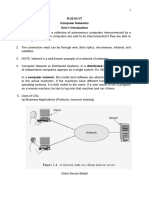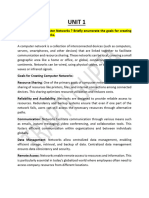Computer Network
Uploaded by
mohammadarsalanibrahim88Computer Network
Uploaded by
mohammadarsalanibrahim88Communicating Networks (Computer Networks)
A computer network is a set of devices (nodes) connected through links. A node can be
computer, printer, or any other device capable of sending or receiving the data. The links
connecting the nodes are known as communication channels. The links may be cables,
telephone lines, radio waves, satellites, and optical fibers, etc.
The main objectives of network is "Resource sharing", and it is to make all programs,
data and equipment available to anyone on the network without the regard to the physical
location of the resource and the user, and to provide high reliability by having alternative
sources of supply. For example, all files could be replicated on two or three machines, so
if one of them is unavailable, the other copies could be available.
Computer Networks means interconnected set of autonomous systems that permit
distributed processing of information. In order to meet the needs of various applications,
networks are available with different interconnection layouts and plans, methods of
access, protocols and data carrying capacities. Networks can be classified on the basis of
geographical coverage.
Classification of Networks
1. Local Area Network (LAN)
2. Metropolitan Area Network (MAN)
3. Wide Area Network (WAN)
1. Local Area Network (LAN):
A local area network is relatively smaller and privately owned network with the
maximum span of 10 km. to provide local connectivity within a building or small
geographical area.
Coverage: Small geographic areas (e.g., a home, office, school, or building).
Speed: High data transfer rates (10 Mbps to 10 Gbps).
Latency: Low latency due to proximity of devices.
Cost: Low setup and maintenance costs.
Ownership: Privately owned (individuals, organizations).
Technology:
o Wired: Ethernet (IEEE 802.3), switches, routers.
o Wireless: Wi-Fi (IEEE 802.11).
Security: Controlled environment, easier to secure.
Examples: Home networks, office networks, school labs.
Use Cases: File sharing, printers, local servers.
2. Metropolitan Area Network (MAN):
Metropolitan Area Network is defined for less than 50 km. and provides regional
connectivity typically within small geographical area. It is designed to extend
over an entire city. It may be a single network such as cable television network,
or it may be a means of connecting a number of LANs into a large network, so
that resources may be shared LAN to LAN as well as device to device
Coverage: A city or large campus (up to 50 km).
Speed: Moderate to high speeds (100 Mbps to 1 Gbps).
Latency: Moderate, higher than LAN but lower than WAN.
Cost: More expensive than LAN due to infrastructure.
Ownership: Public/private entities (e.g., ISPs, governments).
Technology:
o Fiber optics, microwave, Metro Ethernet, or legacy technologies like FDDI.
Security: Requires stronger security than LAN due to broader access.
Examples: City-wide Wi-Fi, university campus networks, cable TV networks.
Use Cases: Connecting branch offices in a city, municipal services.
3. Wide Area Network (WAN)
Wide Area Network provides no limit of geographic area. A WAN provides long
distance transmission of data, voice, image and video information over large
geographical areas that may comprise a country, a continent or even the whole
world. In contrast to LANs (which depend on their own hardware for
transmission), WANs may utilize public, leased or private communication
devices usually in combination.
Coverage: Global or cross-continental (e.g., countries, continents).
Speed: Lower speeds compared to LAN/MAN (a few Kbps to 100+ Mbps).
Latency: High due to long distances and multiple hops.
Cost: Most expensive (leased lines, satellites, undersea cables).
Ownership: Managed by telecom companies, ISPs, or governments.
Technology:
o Leased lines, MPLS, VPNs, satellite links, BGP routing.
Security: Vulnerable to attacks; requires firewalls, encryption.
Examples: The internet, multinational corporate networks.
Use Cases: Global data sharing, cloud services, international communication.
Applications of computer network
1. Communication
Email & Messaging: Real-time exchange of messages (e.g., Gmail, WhatsApp, Facebook,
Slack).
Voice/Video Calls: Platforms like Zoom, Skype, and VoIP services.
Social Media: Platforms like Facebook, Twitter, and Instagram rely on networks for global
connectivity.
Collaboration Tools: Shared workspaces (e.g., Microsoft Teams, Google Workspace).
2. Resource Sharing
File Sharing: Transfer files between devices (e.g., FTP, Dropbox, Google Drive).
Printer/Device Sharing: Shared access to printers, scanners, or storage in offices (LAN).
Cloud Computing: Access to remote servers, databases, and applications (e.g., AWS, Azure).
3. Information Access
Internet Browsing: Access websites, search engines, and online libraries.
Web Services: APIs, SaaS (Software-as-a-Service), and online databases.
Remote Data Retrieval: Access files or systems from anywhere (e.g., VPN, SSH).
4. Entertainment & Media
Streaming Services: Video (Netflix, YouTube), music (Spotify), and live broadcasts.
Online Gaming: Multiplayer games (e.g., Fortnite, MMORPGs) requiring low-latency
networks.
IPTV & Video-on-Demand: Delivering television content over the internet.
5. E-Commerce & Online Transactions
Online Shopping: Platforms like Amazon, eBay, and Alibaba.
Banking & Finance: Online banking, stock trading (e.g., PayPal, Robinhood).
Digital Payments: Secure transaction processing (e.g., UPI, Bitcoin, credit card gateways).
6. Industrial & IoT Applications
SCADA Systems: Monitoring industrial processes (e.g., power plants, manufacturing).
Smart Devices: IoT networks for smart homes (e.g., Alexa, smart lights).
Supply Chain Management: Tracking goods via RFID and networked sensors.
7. Education & Research
E-Learning Platforms: Online courses (Coursera, Udemy), virtual classrooms.
Remote Labs: Access to lab equipment over networks.
Research Collaboration: Grid computing, data sharing (e.g., CERN’s LHC data network).
8. Healthcare
Telemedicine: Remote patient consultations (e.g., video diagnosis).
Electronic Health Records (EHR): Secure sharing of patient data across hospitals.
Medical IoT: Wearable devices (e.g., heart monitors) transmitting data to clinics.
9. Public Services & Governance
Smart Cities: Traffic management, waste control, and energy grids.
Emergency Services: Police, fire, and ambulance coordination via networks.
E-Governance: Online tax filing, voting systems, and public portals.
10. Security & Surveillance
CCTV Networks: Monitoring public/private spaces via IP cameras.
Access Control: Biometric systems and RFID-based security.
Cybersecurity: Firewalls, intrusion detection systems (IDS), and threat monitoring.
You might also like
- Lesson 1-Introducing Basic Network ConceptsNo ratings yetLesson 1-Introducing Basic Network Concepts38 pages
- Communication Describes A Process in Which Two or More Computers orNo ratings yetCommunication Describes A Process in Which Two or More Computers or2 pages
- Lesson 1-Introducing Basic Network ConceptsNo ratings yetLesson 1-Introducing Basic Network Concepts38 pages
- Learn Basics and Be Certified Gear Up With Trends To Learn Computer NetworkingNo ratings yetLearn Basics and Be Certified Gear Up With Trends To Learn Computer Networking43 pages
- Teal Futuristic Technology Facebook CoverNo ratings yetTeal Futuristic Technology Facebook Cover24 pages
- Introduction to Internet & Web Technology: Internet & Web TechnologyFrom EverandIntroduction to Internet & Web Technology: Internet & Web TechnologyNo ratings yet
- 01 BabyBOX Installation Manual (CU3 WRTP54G)No ratings yet01 BabyBOX Installation Manual (CU3 WRTP54G)0 pages
- A Wi-Fi Network For Moose Jaw: A Recommendation Report From The Municipal Wireless Task ForceNo ratings yetA Wi-Fi Network For Moose Jaw: A Recommendation Report From The Municipal Wireless Task Force4 pages
- Computer Applications Technology P2 May-June 2022 MG EngNo ratings yetComputer Applications Technology P2 May-June 2022 MG Eng20 pages
- Designing and Delivering Public Services in The Digital Age OECDNo ratings yetDesigning and Delivering Public Services in The Digital Age OECD38 pages
- [FREE PDF sample] New Perspectives on Computer Concepts 2011 Comprehensive 13th Edition June Jamrich Parsons ebooks100% (2)[FREE PDF sample] New Perspectives on Computer Concepts 2011 Comprehensive 13th Edition June Jamrich Parsons ebooks85 pages
- PROSPECTUS 2020 - 2021: - Chartered by Govt. of Sindh - Recognized by HECNo ratings yetPROSPECTUS 2020 - 2021: - Chartered by Govt. of Sindh - Recognized by HEC28 pages
- ICAB Advance Level Strategic Business Management Study Manual Case & Worked ExampleNo ratings yetICAB Advance Level Strategic Business Management Study Manual Case & Worked Example88 pages
- FTTH BB Access Solution - DasanNetworks - ENo ratings yetFTTH BB Access Solution - DasanNetworks - E22 pages
- قاموس الاعلام العملي محمد يوسف سوسن عبود PDFNo ratings yetقاموس الاعلام العملي محمد يوسف سوسن عبود PDF206 pages
- Investigation Into The Use of Internet by Students A Case Study of Don Bosco Technical Institute, Odumase by Daniel T. AdamaNo ratings yetInvestigation Into The Use of Internet by Students A Case Study of Don Bosco Technical Institute, Odumase by Daniel T. Adama72 pages
- Login To Machine After Password or First Time Login - Remote UserNo ratings yetLogin To Machine After Password or First Time Login - Remote User5 pages
- What Works: Grameen Telecom's Village PhonesNo ratings yetWhat Works: Grameen Telecom's Village Phones16 pages
- 4043 BT Smart Hub-A SI FTTP User Guide 084318 v2 1No ratings yet4043 BT Smart Hub-A SI FTTP User Guide 084318 v2 17 pages
- HP Designjet T930 Printer Series: Boost Team Productivity and Enhance SecurityNo ratings yetHP Designjet T930 Printer Series: Boost Team Productivity and Enhance Security2 pages
- E-Series Introdution To Juniper Network RoutersNo ratings yetE-Series Introdution To Juniper Network Routers158 pages
- Trends Network and Critical Thinking in The 21st Century Culture Finals100% (1)Trends Network and Critical Thinking in The 21st Century Culture Finals115 pages

























































































